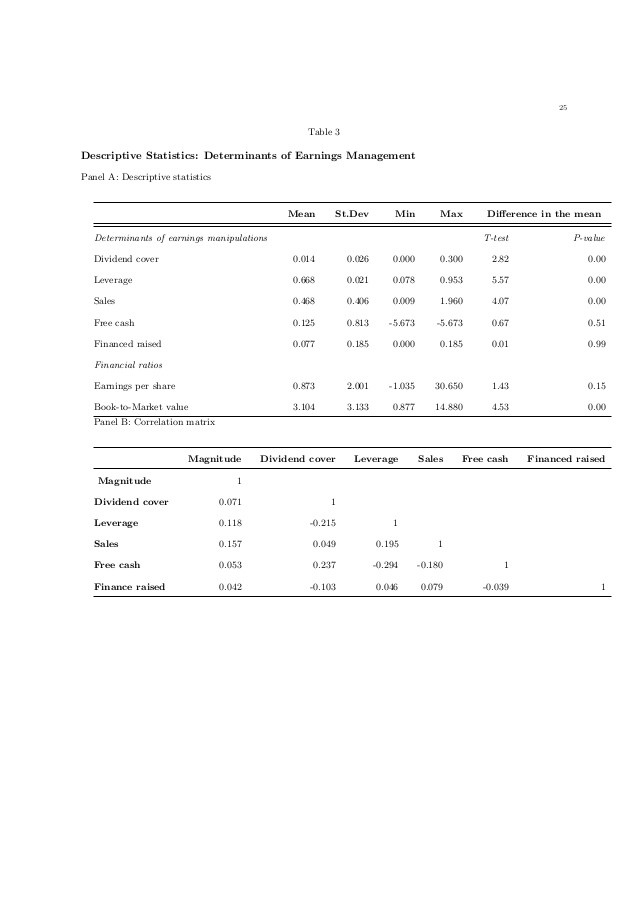What Drives Earnings Management
Post on: 16 Март, 2015 No Comment

wo years ago, SEC Chairman Arthur Levitt charged that widely publicized accounting problems at a number of companies were in danger of undermining U.S. capital markets. One of the processes he blasted was earnings management—an effort among the issuers of financial reports (managements and boards of directors, who have the authority to specify the contents of the reports) “to satisfy consensus earnings estimates and project a smooth earnings path” (see “Arthur Levitt Addresses ‘Illusions,’” JofA, Dec.98, page 12).
The accounting literature defines earnings management as “distorting the application of generally accepted accounting principles.” Many in the financial community (including the SEC) assume that GAAP deters earnings management. However, my opinion, which I have expressed in a letter to Chairman Levitt, is that earnings management results less from distortion of the application of GAAP than from the application of inherently faulty GAAP.
GAAP’s faulty design permits earnings to be managed in two ways. The first is by allowing businesses to report income they have not earned. For example, the FASB staff has called the pooling-of-interests method of accounting that follows a business combination essentially a means to report higher earnings without having to earn them. It is well known that financial report issuers prefer to report the highest income possible. That desire is tempered, though, by fears of attracting increased demands from a company’s stockholders and employees for higher dividends and salaries and from the government for more taxes; there’s also the risk that if the company presents too rosy a financial picture, that will lure new competitors wanting some of the gravy.
Those same financial report issuers, however, have no such reservations about trying to achieve stability of income reporting (also known as smoothing )—the fundamental goal of traditional financial reporting—which is the second way they manage earnings. Their wish for stability of income reporting far exceeds their desire for higher reported income. An example is the way companies have accepted income tax allocation, which both lowers and stabilizes reported income. University of Seattle Accounting Professor Loyd C. Heath, who won the first AICPA Wildman Award for 1978 for his research on the evaluation of solvency through financial reporting, keeps tabs on report issuers’ participation in accounting standard setting. Recently, he quoted a former FASB member who said 95% of the comments the board receives from companies fall into one of three categories: “Don’t make any changes; don’t move so fast; and don’t make income volatile—don’t let it fluctuate.”
HOW GAAP LEADS TO EARNINGS MANAGEMENT
During my recent correspondence with the SEC, Chief Accountant Lynn Turner characterized the issue raised by my criticism of GAAP as “how to make GAAP generate more transparent financial information.” Although he called the U.S. accounting system the best at providing “transparency to a reporting entity’s underlying economic events and transactions,” he said the SEC “would welcome [my] views on actions that might be undertaken” to improve transparency.
I therefore present here how I think tools for earnings management have been made part of GAAP and the only solution to these problems.
Although I find that Chief Accountant Turner’s statement about the quality of the U.S. system’s transparency represents a commendable objective, in my view U.S. GAAP as currently designed for two reasons fails pervasively to provide such transparency. Namely, the application of GAAP
- Results in a company’s failure to report many of the underlying economic events that meet FASB’s criteria for events that should be reported. FASB Concepts Statement no. 2, Qualitative Characteristics of Accounting Information, lists 10 such criteria.
- Introduces distraction into the U.S. accounting system that prevents transparency because it interferes with the portrayal of the events that GAAP does permit companies to report.
And GAAP fails to provide transparency in both these ways for one purpose—to manage earnings.
These two failures are caused by realization and allocation. Realization and allocation are central concepts of current GAAP, but they are the very reason why GAAP does such a poor job of reporting the real-world effects of economic events.
THE POWER OF REALIZATION
The cause of the first failure is that GAAP confines the events financial report issuers are permitted to report mainly to only those that change the quantities of assets and liabilities, such as purchases, sales, receipts and payments. This is the realization convention, whereby only so-called realized changes in assets and liabilities are to be reported.
However, according to FASB, “price changes, interest rate changes, technological changes…and similar events” also affect entities. FASB goes on to say that “to compare…performance by comparing only realized gains [gains reported when quantities change] implies a definition of performance that many people would regard as incomplete and, therefore, as an unreliable representation.”
Consider a reporting entity’s sale for $1,500 of an investment in stock worth $150 a share. That transaction (an event of the kind we now account for—a change in the quantity of an asset) does not affect the entity much, if at all. But an earlier change in the stock’s price from $100 to $150 a share (an event of the kind we generally now do not account for) does affect the entity, as anyone who holds such stock can testify.
FASB concludes that “information based on current prices should be recognized if it is sufficiently relevant and reliable to justify the costs involved and more relevant than alternative information.” In other words, FASB is on record as favoring the reporting of price changes when they occur, though it does not permit such reporting!
FASB DROPS THE BALL
FASB does not comply with its own observations. The board said—in 1978—it “expects to reexamine its pronouncements, pronouncements of predecessor standard-setting bodies, and existing financial reporting practice in the light of newly enunciated objectives and concepts.” In the ensuing 22 years, though, FASB has not made such a reexamination, and there is no sign it will do so in the foreseeable future.

The American Accounting Association characterized a result of FASB’s failure to reexamine GAAP in the light of those objectives and concepts this way: “The most general criticism to be leveled at financial statements in their present form is that they are seriously incomplete. … Because they are substantially transaction-based [and thus report only changes in quantities], they fail to recognize…value changes [not] associated with a transaction” such as for increases in the prices of inventories, land and buildings.
If financial reporting did report on the real-world effects of all relevant economic events, the result would be reported income that is less stable than that under GAAP.
The issuers of financial reports want more stable income reporting—not less—so they prevent GAAP from reporting on those effects. As Rice University Professor Stephen Zeff put it, “There is intense political lobbying against proposals that special interests find to be obnoxious even though the proposed reforms are seen as serving the interests of financial statement users.” Issuers usually disguise their desire and power to prevent more volatility in income reporting. William Ihlanfeldt, a retired issuer, provided an undisguised example in the narrow area of pension reporting, field tests for which were sponsored by the Financial Executives Research Foundation. He said the testing “confirmed that application of…FASB’s tentative conclusions would have introduced a high degree of volatility into companies’ annual pension expense…. This resulted in [FASB’s] making changes in the final standard that helped to reduce volatility…. They did listen, but it was not without considerable prodding.”
THE POWER OF ALLOCATION
Systematic and rational allocation is the cause of the distraction that GAAP introduces, the second failure. Adoption of the definition of accounting in the 1930s—and its retention to this day—as a process of allocation demonstrates that allocation is basic to financial reporting. Allocation characterizes most of financial accounting, including, for example, depreciation; reporting on inventories, investments, income taxes, pensions, goodwill and other intangibles; and liabilities.
Allocation uses smooth (“systematic”) formulas, such as the straight-line and double-declining-balance formulas for depreciation and the compound interest formula for reporting on liabilities. A company selects each formula at the beginning of the period of allocation, supposedly to represent the effects of prospective underlying economic events. Financial report issuers cannot possibly have that foreknowledge about events that may occur after they select the formulas. And events do not occur as regularly as the use of the formulas implies.
Moreover, allocation does not even reflect the effects of underlying economic events. Professor Arthur Thomas, whose pioneering works on the allocation problem were published in 1969 and 1974 by the AAA, said, “Financial accounting’s allocations actually do not reflect the real-world economic states and activities of [companies] to which they purport to refer.”
Allocation merely takes amounts from the financial reporting territory, such as costs, enters them in the financial reporting map and massages them there. Eldon S. Hendriksen and Michael van Breda, the authors from Southern Methodist University of a leading text on accounting theory, have said that annual depreciation, one kind of allocation, is simply a fraction of the total cost and is not necessarily related to occurrences within the year, so it has no real-world connotations. The AICPA said the same thing in Accounting Terminology Bulletin no. 1, Review and Resume, in August 1953: “Definitions are unacceptable which imply that depreciation for the year is a measurement…of anything that actually occurs within the year.”
Accountants defend allocation mainly on the basis of realization and objectivity. Yet both are smokescreens that cover up what Leonard Lorensen, a past member of the AICPA accounting standards staff, has observed: The real goal of those who support allocation is to stabilize reported income.
The smooth formulas used in allocation have that result. Look at what leaders of accounting thought have said about allocation over the decades:
- Professor Henry Rand Hatfield in the early twentieth century called depreciation “only part of a broader scheme whose purpose is to equalize charges between different years.”
- Accounting theoretician Professor Robert Sterling said the purpose of measurement is “to discover variations in empirical phenomena. By contrast, it seems that the purpose of allocation is to make the empirical phenomena appear to be smooth regardless of the actual variations.”
- University of Alabama Professor Thomas A. Lee said allocations are “designed to produce smoothed income flows.”
- Former SEC Chief Accountant Walter Schuetze said allocation is used for managing earnings to smooth “the hills and valleys of change.”
The power of realization and allocation to stabilize income reporting is embodied in the current design of GAAP. Their power to stabilize income reporting is much greater than the power individual issuers have to do so. Those concepts are the main engines driving earnings management today.
Realization and allocation should be eliminated to remove their power to manage earnings.
PAUL ROSENFIELD, CPA, was director of the AICPA accounting standards division for 14 years. A further discussion of his views can be found in his forthcoming book Contemporary Issues in Financial Reporting: A User-Oriented Approach.














